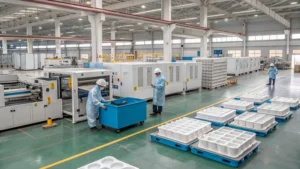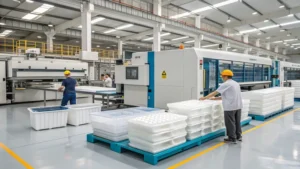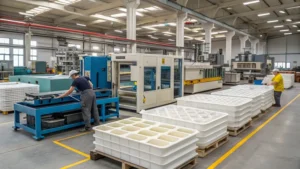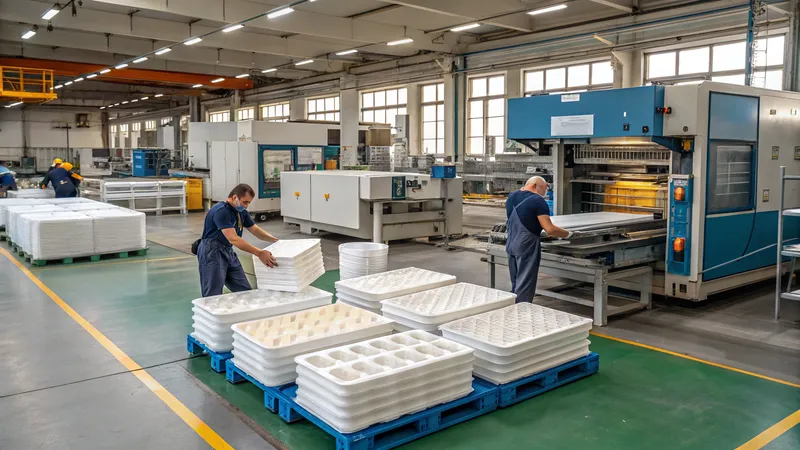
Vacuum forming, a versatile manufacturing process, shapes heated plastic sheets over molds using vacuum pressure, creating lightweight, durable products for industries like packaging, automotive, and signage. In the United Arab Emirates (U.A.E.), this technique supports a growing manufacturing sector1 with cost-effective solutions.
Vacuum forming heats feuilles thermoplastiques2 and uses vacuum pressure to mold them, producing parts for packaging, automotive, and medical applications with low tooling costs.
This article explores the top 10 formage sous vide3 factories in the U.A.E., delving into their services, the process’s technical aspects, and its applications. Due to limited public data, only four companies are confirmed, with six additional manufacturers likely involved in related services.
- 1. Top 10 Vacuum Forming Factories in the U.A.E.
- 2. Qu'est-ce que le formage sous vide ?
- 3. Quelles sont les étapes du processus de formage sous vide ?
- 4. What are the Key Factors in Vacuum Forming?
- 5. Quelles sont les applications du formage sous vide ?
- 6. How Does Vacuum Forming Compare to Injection Molding?
- 7. Conclusion
Top 10 Vacuum Forming Factories in the U.A.E.
| Rank | Company Name | Location | Services | Website |
|---|---|---|---|---|
| 1 | Digi Matrix Technologies L.L.C | Dubai, U.A.E. | Vacuum forming for signage, displays; laser cutting, CNC routing, foam cutting | Yello.ae |
| 2 | Precision Plastic | U.A.E. | Thermoforming (likely including vacuum forming) for polystyrene products | Precision Plastic |
| 3 | Aalmir Plastic Industries (API) | Sharjah, U.A.E. | Thermoforming services, potentially including vacuum forming | Zetarmold |
| 4 | Al Barsha Precision Moulding Dies | Sharjah, U.A.E. | Supplies vacuum forming and thermoforming dies | Zetarmold |
| 5 | Team Visual Solutions | U.A.E. | Vacuum forming and moulding services | Team Visual Solutions |
| 6 | MAKE Abu Dhabi | Abu Dhabi, U.A.E. | Fabrication services, including vacuum forming | MAKE Abu Dhabi |
| 7 | Business Point International | Dubai, U.A.E. | Sells vacuum forming machines, may offer insights or connections to factories | Business Point |
| 8 | You and Eye | Dubai, U.A.E. | Creative production house, likely using vacuum forming for projects | You and Eye |
| 9 | Pleasant Acrylic Fabricators | Dubai, U.A.E. | Works with acrylic sheets, possibly using vacuum forming | Pleasant Acrylic |
| 10 | Arona | Dubai, U.A.E. | Suppliers of solid acrylic sheets, possibly involved in vacuum forming | Arona |
Note: Some companies may not exclusively focus on vacuum forming due to limited online information. Contact U.A.E. industry associations for a definitive list.
The U.A.E. hosts numerous specialized vacuum forming factories.Vrai
The listed companies demonstrate a range of vacuum forming and related services across the region.
All listed companies exclusively perform vacuum forming.Faux
Some companies supply equipment or materials, not necessarily performing vacuum forming themselves.
Qu'est-ce que le formage sous vide ?
Vacuum forming is a cornerstone of plastic manufacturing, offering a balance of cost, speed, and versatility for producing custom parts.

Vacuum forming, or thermoforming, heats plastic sheets until pliable, then uses vacuum pressure to shape them over molds, ideal for lightweight, large-scale parts.
Matériaux communs
| Matériau | Max Thickness | Notes |
|---|---|---|
| ABS | 6 mm | Durable, résistant aux chocs |
| PVC | 5 mm | Flexible, résistant aux produits chimiques |
| Polycarbonate | 6 mm | Strong, transparent |
| PETG | 5 mm | Clear, food-safe |
-
ABS: Used in automotive and industrial parts for its strength.
-
PVC: Common in packaging due to its flexibility.
-
Polycarbonate: Ideal for durable, clear enclosures.
-
PETG: Popular in food packaging and displays.
ABS is a key material in vacuum forming.Vrai
Its durability and ease of forming make it a staple in automotive and industrial applications.
Vacuum forming uses only transparent materials.Faux
It accommodates both transparent (e.g., PETG) and opaque (e.g., ABS) thermoplastics.
Quelles sont les étapes du processus de formage sous vide ?
The vacuum forming process transforms plastic sheets into functional parts with precision and efficiency.
Vacuum forming involves heating plastic, shaping it with a mold and vacuum, then cooling and finishing it for applications like packaging and signage.
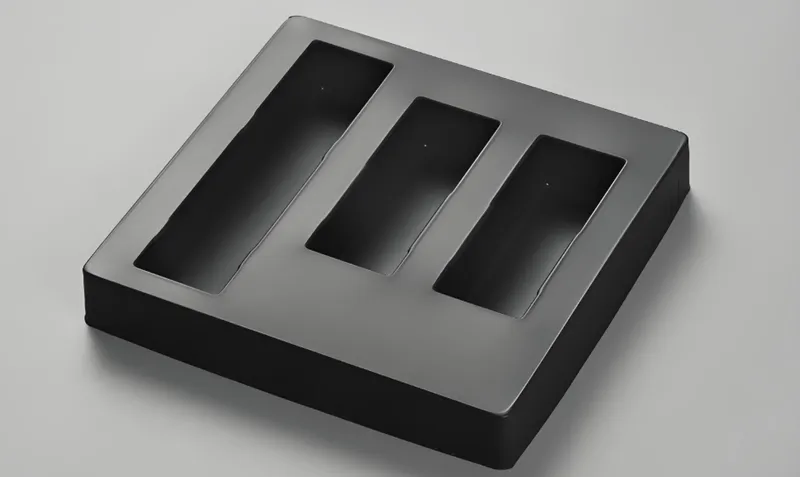
Process Steps
-
Design and Mold Creation: Design parts with CAD, using molds made from wood, aluminum, or composites.
-
Plastic Sheet Selection: Choose thermoplastics like ABS or PETG based on application needs.
-
Chauffage: Heat the sheet (150-200°C) until pliable using infrared heaters.
-
Formation: Apply vacuum pressure (20-27 inHg) to shape the sheet over the mold.
-
Refroidissement: Cool with fans or water mist to solidify the part.
-
Parage et finition: Trim excess material and add finishing touches.
Vacuum forming requires expensive molds.Faux
Molds can be made from low-cost materials like wood for prototyping.
The process ensures uniform thickness.Faux
Thickness varies with stretching, depending on mold design.
What are the Key Factors in Vacuum Forming?
The success of vacuum forming hinges on controlling critical variables to achieve desired part quality.
Vacuum forming depends on sélection des matériaux4, température de chauffage5et conception de moules6, affecting part strength, detail, and production efficiency.
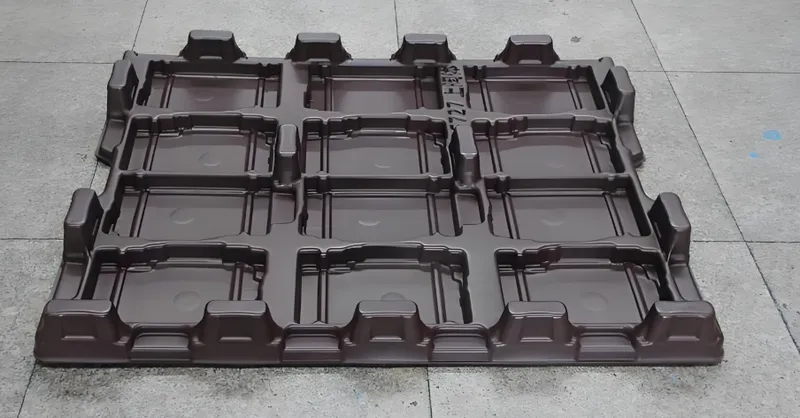
Sélection des matériaux
Choosing the right thermoplastic determines part properties like strength and clarity.
Température de chauffage
Temperatures (e.g., 150-200°C for ABS) must balance pliability and material integrity.
Conception des moules
Draft angles (3-5°) and minimal undercuts ensure easy release and quality parts.
Material choice impacts vacuum forming outcomes.Vrai
Different thermoplastics yield varying strength, flexibility, and appearance.
Quelles sont les applications du formage sous vide ?
Vacuum forming serves diverse industries with tailored, cost-effective solutions.
Vacuum forming produces parts for l'emballage7, automobile8, and medical sectors, leveraging its versatility and low tooling costs.

-
Emballage: Blister packs and trays (e.g., PETG-based food containers).
-
Automobile: Interior panels and dashboards (e.g., ABS components).
-
Médical: Device enclosures (e.g., polycarbonate housings).
-
Signalisation: Displays and kiosks (e.g., acrylic stands).
Vacuum forming is widely used beyond packaging.Vrai
Its applications span automotive, medical, and signage industries.
How Does Vacuum Forming Compare to Injection Molding?
Process Differences
Vacuum forming uses vacuum pressure on heated sheets, while injection molding injects molten plastic into molds.
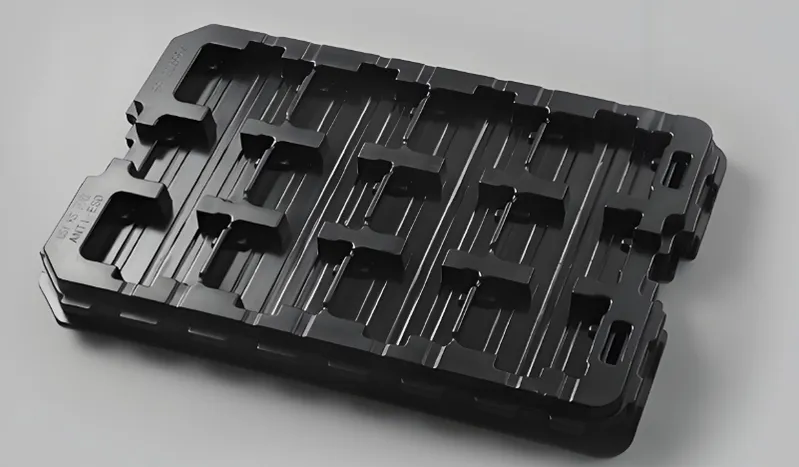
Caractéristiques
Vacuum forming suits large, simple parts; injection molding excels in complex, high-volume production.
| Fonctionnalité | Formage sous vide | Moulage par injection9 |
|---|---|---|
| Coût de l'outillage | Faible | Haut |
| Complexité des pièces | Simple to moderate | Haut |
| Volume de production10 | Faible à moyen | Haut |
Vacuum forming is more cost-effective than injection molding for all volumes.Faux
It’s cheaper for low to medium runs but less efficient for high volumes.
Conclusion
Vacuum forming is a vital process in the U.A.E., supporting industries with efficient, affordable plastic parts. The top 10 factories listed showcase the region’s capabilities, though further research may refine this list. By understanding its materials, steps, and applications, businesses can harness vacuum forming’s benefits effectively.
-
Discover insights into the U.A.E. manufacturing sector's growth and innovations, which can inform your understanding of regional industry trends. ↩
-
Learn about thermoplastic sheets and their significance in manufacturing processes, including vacuum forming, to grasp their role in product development. ↩
-
Explorez ce lien pour comprendre le processus de formage sous vide et ses applications dans diverses industries, en améliorant votre connaissance des techniques de fabrication. ↩
-
Understanding material selection is crucial for achieving optimal part properties in vacuum forming processes. ↩
-
Exploring heating temperature's impact can help you optimize your vacuum forming process for better results. ↩
-
Learning about mold design best practices can significantly enhance the quality and efficiency of your vacuum formed parts. ↩
-
Discover how vacuum forming revolutionizes packaging with cost-effective and versatile solutions. ↩
-
Learn about the advantages of vacuum forming in automotive parts production and its impact on design. ↩
-
Learn about Injection Molding to discover its process and why it's preferred for complex, high-volume production. ↩
-
Understanding Production Volume can help you choose the right manufacturing method for your project needs. ↩



